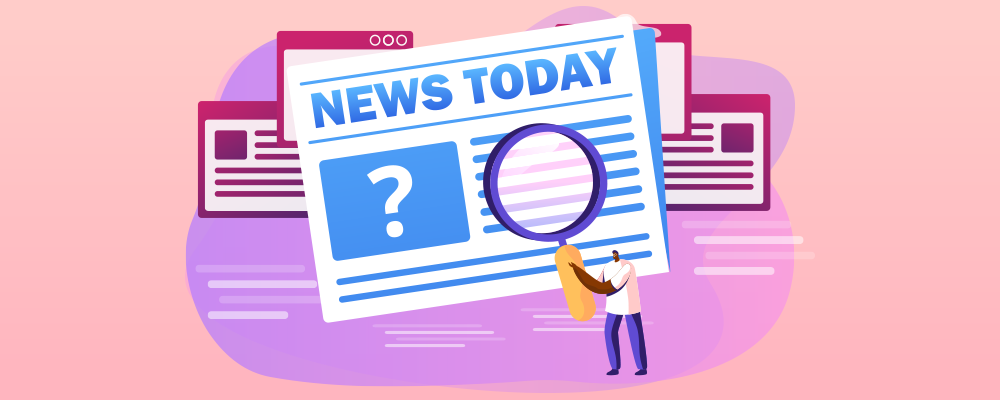It may sound a little strange that we should need to learn how to read the news. After all, there’s nothing particularly obscure or technical about the language that’s used in news reports. But today, with so much talk about ‘fake news’, and so much scepticism about bias in the media, the issue of how events are presented to us has become a major concern for society. Understanding how the news industry operates, and reflecting how we, as consumers, interact with it, can be very useful in the fight against the corrupting influence of ‘fake news’.
As a follow-on from short films created by The Open University on the topic, we’ve written some top tips, questions to ask yourself and suggestions to consider you can use when you navigate the media landscape. These tips will help you think critically, come to your own conclusions about the news you are consuming and help you to distinguish dependable information from disinformation.
1. Is the article meant to be a factual recounting of events, or is it a piece of commentary which is built around the writer’s opinion of the events?

More and more reporting is opinion-based these day, and while there’s nothing inherently wrong with this, it’s useful to distinguish between the two. Opinion-based reporting includes the author’s own interpretation of events, which can give a very particular perspective on the news. By distinguishing factual reporting from commentary you’re in a better position to form your own judgements about the situation.
2. Who’s the author of the story, and who’s publishing it?

This question comes in two parts, the individual author, and the overarching news organisation. With respect to the author, you may want to consider how credible they are, and whether they have a solid background in news journalism, or whether they mostly post provocative stories meant to attract attention on social media. You may even want to think about any preconceived ideas you have about the author, and whether these are likely to affect how you interpret the article.
With respect to publishing organisations, from newspapers to social media accounts, it can be useful to look at who funds them, and what this funding or governance is likely to mean for the perspective they’re taking on events. On Twitter, for example, posts by state-media organisations are flagged as such, because they’re often used by those in power in those countries to push a particular political agenda.
3. Read more than just the headline of the story.

It’s often the case on social media that people will just read a headline, and then share the story based on their reaction to this. However, there are a number of dangers with this. Firstly, the article itself will obviously have details and nuance that you can’t fit in a one-sentence headline (you can only have 80 characters in a social media headline), and so relying entirely on the headline is likely to be misleading. It’s also worth remembering that the purpose of the headline is not simply to summarise the content of the article, but also to pique readers’ interest. As such, the headline is likely to present things in starker and more sensational terms than the article itself. It’s also the case that headlines are rarely written by the author of the article, but by a copyeditor, which means there’s a further remove from the content of the story.
4. Check the links, references and sources that are provided for the claims made in the article.

This piece of advice might mean that digesting news takes a little longer, but you shouldn’t need to look very far for the evidence supporting the news story and if you do, this should get you thinking. Good news sources will provide links in their online articles showing where they've got their information from. As with all knowledge, an understanding of where it’s come from can give a good sense of how reliable it is. You can reuse points one and two to help you think about the origin of the sources and their reliability.
5. Has the article been corrected or updated at any stage?

Legitimate news outlets will add a note to an article if it’s been changed since first publication. It can be a good idea to look at when such corrections took place in relation to the original time and date of publication, and also to see what type of ‘mistake’ has been corrected. This can give you a sense of the sort of guidelines by which news organizations operate and can help you be more critical when reading the news more generally. After all, news reporting isn’t immune from making mistakes, especially when it’s reporting on something which is live and liable to change by the minute. In other words, good reporting aims at objectivity, and part of this aim is to admit to mistakes and correct them when new information becomes available. Less reliable reporting, on the other hand, may avoid this level of transparency, and through ducking such journalistic responsibility end up contributing to the spread of misinformation itself.
You may also find the following links helpful:
- Full Fact – an independent fact checking organisation for the UK.
- Snopes – a US-based fact checking organisation.
- Democracy Classroom - a set of resources from organisations supporting young people to engage in elections.

This resource is part of the Active Citizenship in Wales collection.
Discover more on the collection homepage.






Rate and Review
Rate this article
Review this article
Log into OpenLearn to leave reviews and join in the conversation.
Article reviews